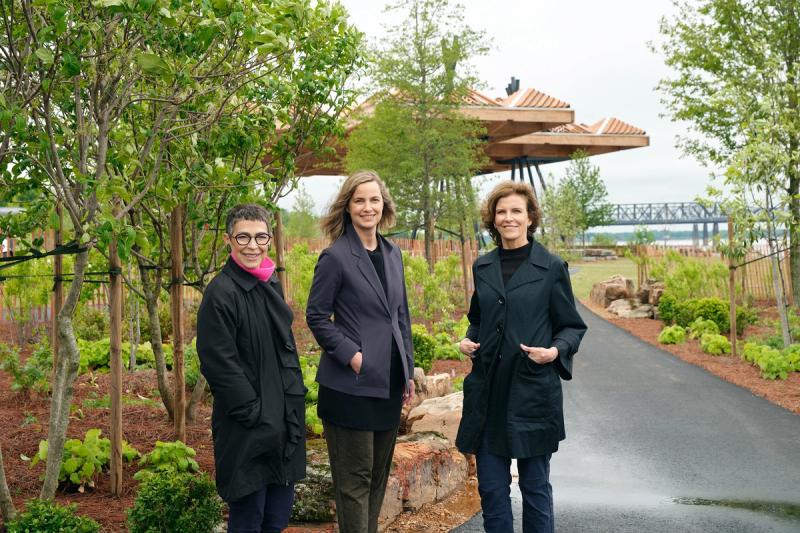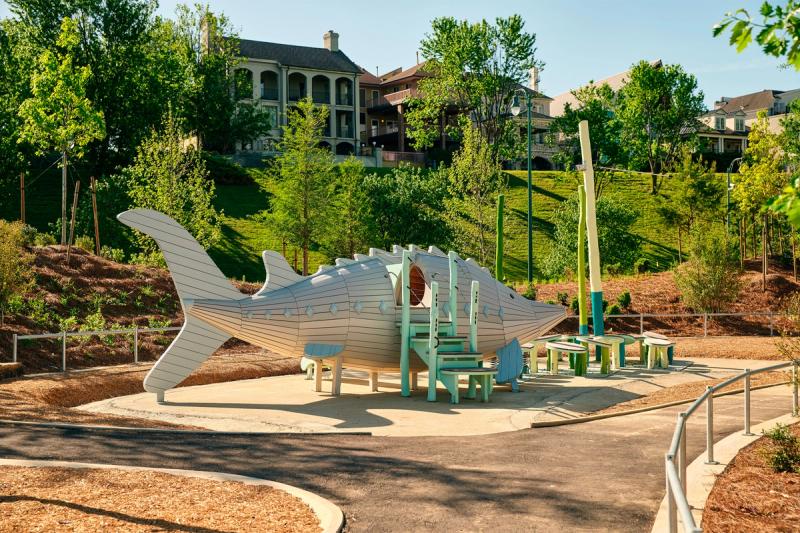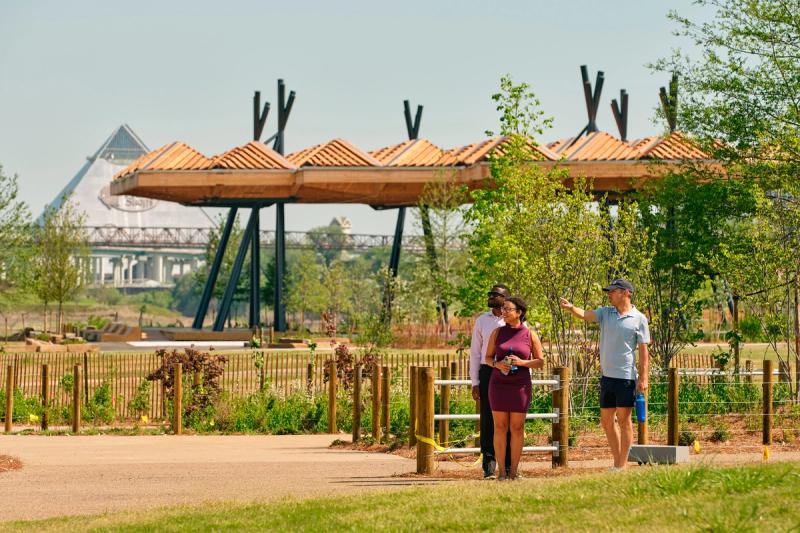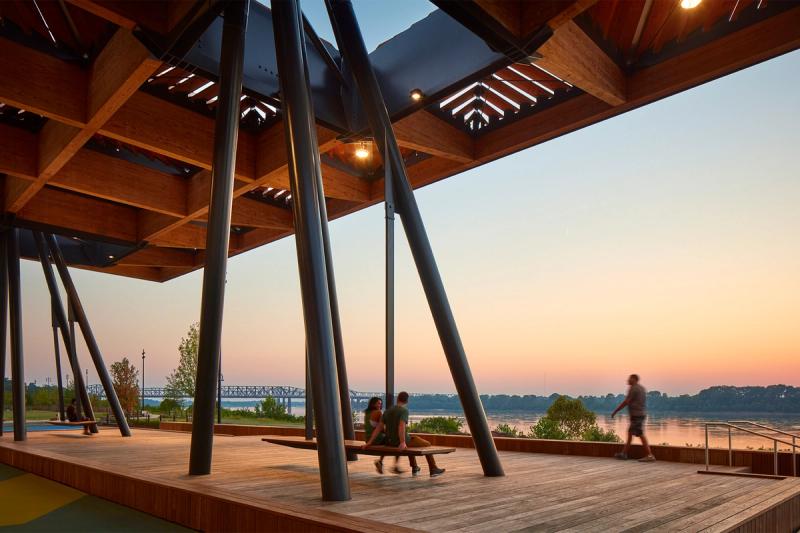
A Dynamic, City-Defining Riverfront Park Grows in Memphis
In the whirring, flashing, globe-spanning machine that is American popular culture, Memphis, Tennessee—population 620,000—operates as one of those miraculous little cogs that performs hundreds of vital functions without ever wearing out. Products bearing its signature stamp go back to the dawn of modern media, and keep popping up: W.C. Handy’s 1912 song “Memphis Blues” was a key evolutionary link between ragtime and jazz; just over 50 years later, Bob Dylan namechecked it with his seminal folk-rock anthem “Stuck Inside of Mobile with the Memphis Blues Again”; 15 years after that, a group of radical Italian designers in Milan, listening to the Dylan track while thinking up a name for their incipient movement, ultimately settled on “Memphis Group.” The Piggly Wiggly supermarket chain got its start in the city in 1916, and Holiday Inn opened its very first location there in 1952. Today, Memphis is home to the headquarters of FedEx, AutoZone, and International Paper. Against certain odds, the little town on a bluff over the Mississippi has entered legend as a mecca of Americana, living up to the curiously monumental name its founders gave it in 1819.
Unfortunately, that’s not quite how Memphians tend to see their city these days. Carol Coletta is a longtime local, and a key force behind the city’s new Tom Lee Park—a project that, as she explains, has had to contend with residents’ chronically low expectations for what Memphis can be. “People look around and say, ‘I can’t believe we built this here,’” she says. “I say, what makes you think we couldn’t?” With poverty and unemployment rates at nearly twice the national average, the enduring pessimism of her fellow citizens may not have been entirely unfounded. Yet in her role as CEO and president of the Memphis River Parks Partnership, Coletta seems convinced that the 30-acre waterfront greenspace—designed by the celebrated Chicago-based firm Studio Gang, in tandem with landscape specialists SCAPE (whose founding principal, Kate Orff, was the guest on Ep. 132 of our At a Distance podcast) and a host of accomplished collaborators—could be just what the city needs to remind of its vaunted place in the cultural canon and help push it forward.

Once a sterile expanse of dust and grass intended chiefly to act as a flood-prevention dyke, the site where the park now stands is in the heart of the city in more ways than one. As Memphis Mayor Jim Strickland put it, speaking to visitors on the new park’s opening day, “This is where it all began: Memphis and the river.” Scarcely a five-minute walk north of the new park is the old cobblestone landing where paddle steamers once delivered the cotton that fueled the city’s rapid growth. Now under restoration, the area also speaks to the darkest aspects of Memphis’s history, its bales and riverboats all packed and powered by slave labor. More recently, the riverfront has also been the place where various visions for the future of Memphis have been launched and then swiftly foundered (witness the vast concrete hulk on nearby Mud Island, an early-1980s recreational facility that cost $63 million when built and has since fallen into near-total disuse). For a city looking for a reset, the eastern bank of the Mississippi seems like just the place to start.
But making Tom Lee Park fill that particular bill has been no easy task. Named for a heroic Black boatman who rescued dozens of drowning steamboat passengers from a 1925 wreck, the project has been enmeshed in the complex politics of race and class in the Delta region. The annual Memphis in May festival has long occupied the site, drawing a boisterous crowd of music fans and BBQ enthusiasts; as one supporter told the Commercial Appeal, the existing park was “already great,” while the $63 million renovation (the price tag an uncanny parallel with the old Mud Island development) would mostly stand to benefit the owners of upscale single-family homes at the top of the nearby hill. To convince city leaders to get on board with the project, Coletta and company had to assure them the festival would still be able to use the park, as would residents beyond the ridge. “One of the poorest congressional districts in the country is only a five-minute walk away,” says George Abbott, director of communications for the Memphis River Parks Partnership. “This is in their front yard, too.”
“We wanted to turn the city around to face the river,” Jeanne Gang, the founding principal and partner of Studio Gang, says. The Chicagoan has been involved with researching the Memphis waterfront since 2016, and her firm developed a far-sighted scheme to reimagine the city’s relationship with the historic waterway. To make it possible, Gang turned to SCAPE, which oversaw a complex process of regrounding that turned the once-treeless site into a flourishing ecosystem of local flora and fauna, with extensive plantings of white oak, sweet gum, and thick bankside plantings that provide shelter for butterfly populations while buffering the site against floodwaters. The architects then cast a still-wider net, pulling creative demiurge and fellow Windy City denizen Theaster Gates, who produced an amphitheater-like circle of fat basalt stools—a “listening circle,” as he describes it—as well as James Little, who created an elaborate painted floor for the basketball court standing at the center of the park, its prominence underscored by a vast “Sunset Pavilion” structure that straddles it. For a city where basketball is “second only to religion,” as Abbott says, it’s a suitably grandiose setting.

On opening day, crowds strolled down Gang’s elegantly winding paths and past colorful hammocks and a statue of Tom Lee himself pulling survivors from the water—the only relic of the previous quasi-park. It seemed like the park had at long last found its audience; as if to prove Abbott’s point, a gospel choir performed on the court, their praises ringing to the timber-coffered pavilion roof with its slender metal piers and oversized dangling swings. “When people think about Memphis, this is what we want them to think about,” says Tyree Daniels, the River Parks Partnership’s board chair.
As an image of the city, the park’s refined organicism—the prim wood-clad structures housing the bathroom and dining amenities, the delicate steel bridge and log-pile seating feature—seems a promising if somewhat peculiar way to go: doubtless aware of both the grandeur and the tragedy of the Memphis of mythos, Gang and her fellow designers decided to favor an approach whose quietude and abstraction holds much of that Memphis-ness at bay. Neither Gates’s contribution, couched by the artist as an attempt to “emphasize racial equity,” nor Little’s, named in honor of local police-brutality victim Tyre Nichols, quite bring the narrative of the city full circle—though it’s hard to say that any public space could do that, or much less that a public space could revive a troubled city’s prospects at a single stroke. But if Tom Lee Park can bring just a little bit of Memphis back to itself, that will be more than enough.






